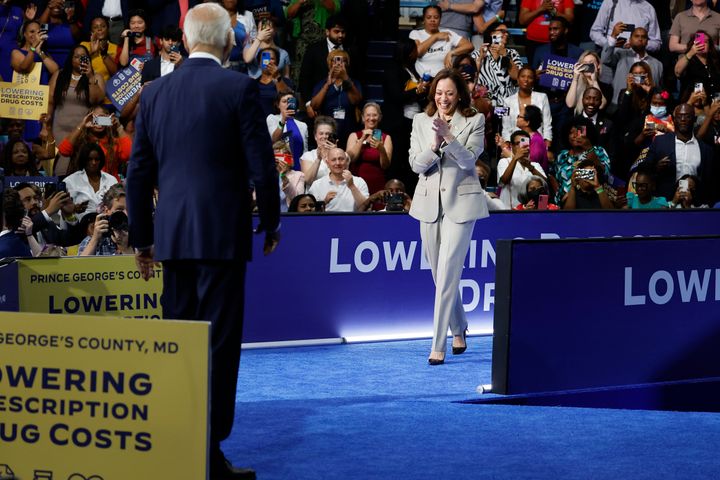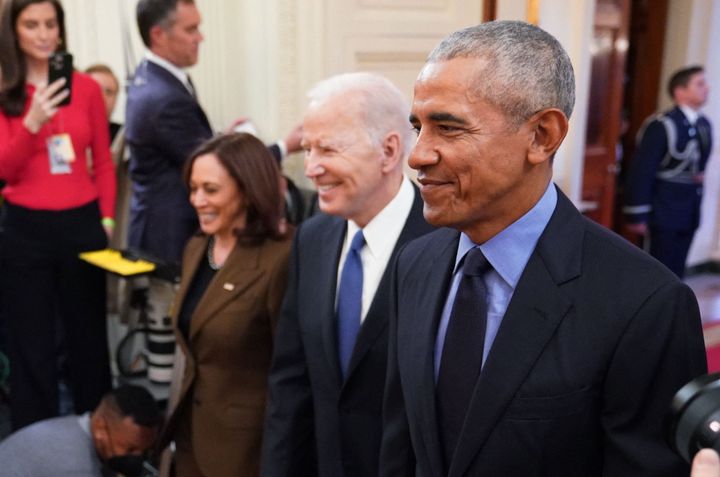This article is part of HuffPost’s biweekly politics newsletter. Click here to subscribe.
Thursday was a pretty big day for health care policy — and, as it turns out, for object lessons in the importance of elections.
That was the day the Department of Health and Human Services announced it had secured agreements from pharmaceutical manufacturers to reduce the prices of 10 expensive drugs that millions of Medicare beneficiaries take to treat blood clots, diabetes and other serious conditions
The agreements were the result of a monthslong negotiation process, the first in what will now become an annual ritual thanks to the Inflation Reduction Act. That law, widely considered President Joe Biden’s signature legislative accomplishment, included several other reforms to lower drug prices. These changes should add up to real, tangible savings for some seniors and people with disabilities, into the hundreds, and sometimes thousands, of dollars a year.
The Inflation Reduction Act celebrates its second anniversary today. That’s one reason for the timing of the announcement.
Another is that the Democratic National Convention takes place next week, the election just 10 weeks after that. And Vice President-slash-Democratic nominee Kamala Harris wants voters to connect this win to her candidacy, reminding them she was a big supporter of the Inflation Reduction Act. In 2022, she literally cast the decisive, tie-breaking vote for it while serving in her constitutional role as presiding officer in the Senate.
Harris also wants voters to know she’s eager to do more. On Friday, Harris proposed a series of reforms that would strengthen the government’s ability to lower drug prices ― by, for example, expanding the Inflation Reduction Act’s $35 cap on insulin so that it applies to all purchases, not just those for people on Medicare.

Of course, the need for that extension is a reminder of the ways the Inflation Reduction Act represents only modest progress, leaving a ton of unfinished business when it comes to making prescription drugs truly affordable.
The new agreements, after all, apply only to prices for people buying drugs through Medicare. The savings in some cases will be small or nonexistent, depending on the kind of drug insurance beneficiaries have and whether the insurers managing them were already getting substantial discounts. And the new prices don’t actually take effect until Jan. 1, 2026.
You can look at the news as reason for celebration or for disappointment ― or a bit of both, I suppose. But whatever your reaction, you should also see the news as a case study in why national and congressional elections matter, in ways that are not always as obvious as they might seem.
A Brief History Of Trying To Tame Drug Prices
The idea of giving the federal government the power to negotiate drug prices, which is what the governments of other economically advanced countries do, goes back at least to the 1980s. But efforts to make it happen in the U.S. consistently ran into tough opposition — from conservatives and, especially, from the drug industry.
You could see that opposition at work in 2003 when then-President George W. Bush signed the bill that first created a drug benefit for Medicare. It was Republican legislation that passed with a few votes from more conservative Democrats. Not only did that law fail to give the government price negotiation authority, it explicitly prohibited the federal government from meddling in prices.
The same kind of opposition was again at work in 2009, when then-President Barack Obama and Democratic leaders were trying to pass what became the Affordable Care Act. In order to avoid a fight with the drug industry, which had killed past efforts at expanding insurance coverage, the law’s architects promised to exclude a provision giving the federal government leverage over prices.
The Obama episode was especially instructive. Democrats for a time had a 60-seat, filibuster-proof majority in the Senate. But roughly a third of those were more conservative lawmakers, mostly from formerly Democratic states in the process of turning Republican.
Desperate to hold onto their seats, they were skittish about big Democratic legislation and heavily dependent on drug industry support for their campaigns. Had Obama and Democratic leaders not ceded to the drug industry and the lawmakers over which it held sway, chances are good the Affordable Care Act wouldn’t have passed at all.

In the decade that followed, most of those Democrats lost their seats, costing the party congressional majorities they only got back in 2018 (in the House) and 2020 (in the Senate). The new Senate majority was the thinnest possible, just 50 seats, but with Harris’ tie-breaker it was enough to pass budget-related legislation and — critically — it had come together mostly with members who were less conservative, less in thrall to Big Pharma, or both.
Among the Senate newcomers in 2020 were two Georgia Democrats, Jon Ossoff and Raphael Warnock; over in the House, the Democratic majority included members such as Michigan’s Elissa Slotkin. All represented constituencies that leaned more red than blue but were trending slowly in a Democratic direction. Not coincidentally, all three lawmakers were wholeheartedly in favor of aggressive action to bring down prescription prices — and all voted “yes” on the IRA reforms.
Still, it wasn’t quite enough to pass strong legislation on prescription prices. Democratic leaders had to wrangle votes from (then-Democratic) Sen. Kyrsten Sinema of Arizona and a group of House counterparts with ties to drug lobbies. The price these lawmakers extracted was compromise that limited the reforms — by, for example, narrowing the scope of drugs subject to negotiation and nixing extension of some price limits beyond Medicare.
It’s an instructive lesson in the way even tiny, one-time changes in election outcomes can have big, far-reaching effects on policy. It’s hard not to imagine that, in a world where Democrats had just a handful of more votes back in 2022, they could have passed significantly stronger drug pricing reforms ― making a wider array of drugs subject to price negotiation, for example, or extending some of the reforms outside of Medicare.
They might have even secured some of the other policy goals they had been seeking, like creating a paid leave program or making big investments in child care.
Conversely, in a world where Democratic caucuses were slightly smaller, they probably would have gotten even less. Or maybe nothing at all.
What was true in the past is just as true now heading into November, and not just because so much is riding on the presidential race. The difference of just two or three House members, or a single measly senator, could be the difference between future legislation that does a lot or does a little ― or doesn’t happen at all.
Disclaimer: The copyright of this article belongs to the original author. Reposting this article is solely for the purpose of information dissemination and does not constitute any investment advice. If there is any infringement, please contact us immediately. We will make corrections or deletions as necessary. Thank you.
